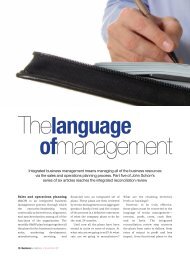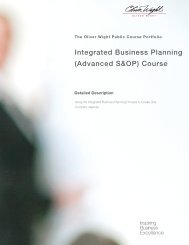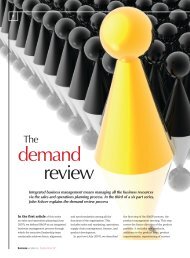Henkel Mexicana AC Division - Oliver Wight Americas
Henkel Mexicana AC Division - Oliver Wight Americas
Henkel Mexicana AC Division - Oliver Wight Americas
You also want an ePaper? Increase the reach of your titles
YUMPU automatically turns print PDFs into web optimized ePapers that Google loves.
OLIVER WIGHT CASE STUDY SERIES<br />
<strong>Henkel</strong> <strong>Mexicana</strong> <strong>AC</strong> <strong>Division</strong><br />
Takes the First Step On The<br />
Journey To Sustainable High<br />
Performance And Profitability<br />
“Proyecto Impacto addressed the basic needs our<br />
company had to acheive our strategic goals...”<br />
Jorge Treviño<br />
General Manager<br />
<strong>Henkel</strong> <strong>Mexicana</strong> <strong>AC</strong> <strong>Division</strong>, Latin America North<br />
®<br />
together we make a difference
The Need For Structure:<br />
Adopting and implementing a structured methodology for sustainable high<br />
performance and profitability provided <strong>Henkel</strong> <strong>Mexicana</strong> <strong>AC</strong> <strong>Division</strong> with quite a<br />
challenge. It required adopting a structured methodology; an integrated business<br />
model with correctly sequenced tasks. “Proyecto Impacto” was launched<br />
successfully and concluded in <strong>Oliver</strong> <strong>Wight</strong> Class A awards in Planning and Control.<br />
Among The Bottom-Line Benefits:<br />
Customer on-time shipment performance now exceeds 98 percent and executable<br />
sales plan performance is consistently within 5 percent of target as a result of<br />
demand forecasts being accurate within tolerance for product families and<br />
subfamilies. Inventory record accuracy now exceeds the Class A threshold of 95<br />
percent which contributes to production efficiency, exceeding prior levels by at least<br />
two percentage points, which equates to millions in savings. Mill compliance with<br />
the master schedule exceeds 95 percent, which enhances the ability to keep<br />
commitments to customers.<br />
Excellence Program Including S&OP to Improve Service Levels<br />
In 2005, the Adhesives <strong>Division</strong> Board of Directors decided that the service level of<br />
<strong>Henkel</strong> <strong>Mexicana</strong> <strong>AC</strong> and all associated processes were unacceptable. Their stated<br />
vision is “To be recognized as the world's leading and most competent company for<br />
adhesives, sealants, and surface treatments”. The board members made the<br />
decision to launch a continuous improvement program, including Sales & Operations<br />
Planning. <strong>Henkel</strong> headquarters in Germany had been working on an Excellence<br />
Program with <strong>Oliver</strong> <strong>Wight</strong> Europe's Dave Manning and felt that <strong>Henkel</strong> <strong>Mexicana</strong><br />
<strong>AC</strong> could benefit from a similar program. The first step taken, by Wilson Stefano Jr.<br />
of <strong>Oliver</strong> <strong>Wight</strong> <strong>Americas</strong>, was to conduct a Basic Assessment - completed in March<br />
of 2006. The results showed they were operating at a Class “D” level. This rating<br />
drove them to focus on Planning and Control using the <strong>Oliver</strong> <strong>Wight</strong> ABCD Checklist<br />
for Operational Excellence - Fifth Edition.<br />
The Case for Change:<br />
Many areas of operations and planning were inefficient, impeded, or non-existent<br />
causing management to seek a better way. There was dissatisfaction on the part of<br />
the Board of Directors with the service level, the processes, and the associated costs.<br />
The company lacked a formal Sales and Operations Planning process. Overall, there<br />
was a misalignment with the Vision. No structured process existed to improve sales<br />
plan accuracy and sales had tunnel vision to the top-line number. Supply Chain<br />
Integration was lacking, contributing to difficulties in managing seasonality. Silo<br />
thinking caused poor communication and cooperation. There was little or no Supply<br />
Chain Collaboration, reducing control of the business. Inventory levels were not<br />
considered a business priority. There was no structured process to improve data<br />
quality. Systems issues/insufficiencies were not addressed. Root cause analysis to<br />
support KPI improvement was inconsistent. There was no formal education program<br />
within the company, and the culture of the business was not conducive to<br />
improvement.<br />
Throughout the Project:<br />
The Executive Team regularly communicated their commitment to change the way<br />
they were doing business and to adopt the culture and behavior of a Class A<br />
organization. General Manager Trevino said “It started with a change of culture<br />
where people were thinking in silos rather than (as) an integrated business unit.”<br />
They reinforced that it requires discipline and common sense. The leadership of the<br />
project was directly taken by board members and cascaded through the entire<br />
organization with strong support from Manual Macedo, the president during the<br />
project.
Changes:<br />
Sales and Operations Planning was implemented.<br />
Capable Supply Planning and Control was implemented after the base line<br />
was established.<br />
The executive team communicated clearly to the entire organization about<br />
their commitment and understanding of the journey and the focus required.<br />
Teams were organized to facilitate change and lean execution.<br />
A sustainable culture change was achieved supporting the new way of<br />
operating the organization.<br />
A formal education and training program was established that supported<br />
the changes required.<br />
Task Teams:<br />
59 participants were grouped into 8 teams; each team had a specific piece of<br />
the project with dedicated responsibilities; the goal being the application of the<br />
<strong>Oliver</strong> <strong>Wight</strong> Integrated Business Model. Jean Daniel Mottais points out, “(A)<br />
project such as "Class A" requires a full-time project leader in order to assure<br />
its complete implementation within a set time frame (to)… motivate, plan,<br />
control, and finally assure that all the team is aligned to the common target:<br />
Achieving the Class A certification.” Assessments were conducted throughout<br />
the project to monitor performance, and results were communicated<br />
continually. Maria Salceda points out; “From the Shared Service function's<br />
point of view, it was of absolute help to be part of it, we had the opportunity<br />
to know more about the business, to put all the information that we manage<br />
daily in a more objective and measurable way and it made our work (of) much<br />
more of value... Now we have the process, we aligned our internal tools and …<br />
(will) work to continue improving our performance within the company.”<br />
Maria is Head of Corporate Communications for <strong>Henkel</strong> Latin America North.<br />
Knowledge Transfer:<br />
An education program was established to support the project. Together with<br />
<strong>Oliver</strong> <strong>Wight</strong>, several courses and workshops were conducted including<br />
Business Excellence, Demand Management, Supply Management, and Sales<br />
and Operations Planning. Stefano indicates: “Many companies omit this<br />
important phase of their project. But without it, the concept of lean execution<br />
and the culture of continuous improvement could not have been<br />
implemented.” Learning by doing was the critical success factor, but the<br />
correct education program and the correct sequence, supported by Stefano,<br />
was the baseline to transform the project into a total success and implement<br />
the culture of Class A to become a world-class organization.<br />
Business Excellence Implemented<br />
Integrated Business Planning processes and tools (technology solution) to<br />
support these processes were implemented; Key Performance Indicators were<br />
established, monitored, and used to improve the processes. These changes<br />
were made and measured using the <strong>Oliver</strong> <strong>Wight</strong> Class A Checklist for Business<br />
Excellence, Sixth Edition.
Improvements include:<br />
PRODUCT LIFE MANAGEMENT PROCESS: - The implementation of the product<br />
management process, a process to track progress from the origin of an idea to the final<br />
product launch, included three years post-launch. Part of this process is an innovation tool<br />
to support and manage the pipeline of the new ideas. Portfolio management is an<br />
important part of the process that manages the lifecycle of a product. It is integrated into<br />
the S&OP cycle. Launch control is a “structured process” to manage from the launch<br />
through to the performance demonstrated by the product, including:<br />
GP - Gross Profit management; comparing the estimated and the actual<br />
Inventory level - adjustments made during the initial phase of the launch<br />
Demand plan - data collection and adjustment to understand the performance and<br />
project the future.<br />
KPIs were implemented to measure the performance of the product management process.<br />
The first measurement is the project schedule performance - planned launch date versus<br />
reality for all projects, and the second one is the milestone schedule performance - the<br />
measurement of the milestones achieved in the stage and gate process.<br />
DEMAND MANAGEMENT / DEMAND PLANNING: - A formal demand management<br />
process was implemented and included the demand planning process and demand control<br />
process which involved the sales force. General Manager Trevino adds, “One key area<br />
which made the difference was the demand planning process which was barely<br />
established. By getting the right input into the process by assessing market and customer<br />
needs, we were able to increase our fill rate levels, therefore our invoicing, while reducing<br />
our net working capital at the same time." Once the demand planning function was<br />
created, it was necessary to add a demand planner.<br />
KPIs - Sales plan performance/accuracy at aggregate and detail levels:<br />
The measurement of the sales plan or demand plan performance at the aggregate,<br />
family, and subfamily levels was important in order to make the demand<br />
management process a success and add value to the business.<br />
Sales compensation system:<br />
Another significant initiative was to make changes to the compensation system for<br />
the sales force. Typically the organization calculated compensation based on the<br />
amount of money made by the business which injected bias into the sales plan, so<br />
the compensation system, now based on the accuracy of the mix planned, was<br />
revamped.<br />
A rolling sales plan going out 18 months displays the first three months at a detail<br />
level and the remaining months at an aggregate level. For ease of use and to support<br />
the promises to the shareholders, the horizon was extended to 18 rolling months.<br />
MASTER SCHEDULING / MASTER PLANNING - Closed-loop processes - MP / MPS / MRP /<br />
SFC - were implemented.<br />
DATA <strong>AC</strong>CUR<strong>AC</strong>Y - Steps were taken to improve the data accuracy on bills of material,<br />
routing structures, work locations, item master data, and supporting data, as well as<br />
inventory record accuracy.<br />
TOOLS - The mySAP was implemented successfully in August 2007 making use of<br />
functionality to support the processes.<br />
PEOPLE AND BEHAVIORS - The culture of Class A really became ingrained during and after<br />
the final certification by <strong>Oliver</strong> <strong>Wight</strong>.<br />
ALL CLASS A KPIs were achieved and sustained for three months prior to the final<br />
certification.
“The process allows … the company to be<br />
focused and aligned to the key priorities...”<br />
- Rodolfo Milan<br />
Class A Certifications and Benefits Received - PROYECTO IMP<strong>AC</strong>TO<br />
<strong>Henkel</strong> <strong>Mexicana</strong> <strong>AC</strong> <strong>Division</strong> received two recognitions simultaneously from <strong>Oliver</strong> <strong>Wight</strong>:<br />
The <strong>Oliver</strong> <strong>Wight</strong> ABCD Checklist for Operational Excellence - Fifth Edition - Chapter 5 -<br />
Planning and Control Processes and The <strong>Oliver</strong> <strong>Wight</strong> Class A Checklist for Business Excellence<br />
- Sixth Edition - Class A Milestone Award in Capable Planning and Control - the first milestone<br />
of eighteen.<br />
These accomplishments were the result of <strong>Henkel</strong> <strong>Mexicana</strong> <strong>AC</strong> <strong>Division</strong> receiving benefits<br />
such as:<br />
Quantitative<br />
Savings of 2,336 TEUR in one year from:<br />
- Reduction in manufacturing costs<br />
- Inventory cost reductions<br />
- Improved position in Cash - Net Working Capital<br />
- Improvement in customer on-time delivery performance and reductions in backorders<br />
Qualitative<br />
Team work - development of cross-functional capabilities led to an increased<br />
understanding of other colleagues' roles.<br />
SAP - technology solution - knowledge was broadened.<br />
Common language and set of performance measures are being used.<br />
Discipline has been instilled.<br />
Integration and communication has improved - developing a “strong team spirit”.<br />
A rolling, long-term view of the business is now available.<br />
Management has attained full control of the business.<br />
Established goals were aligned throughout the organization.<br />
There is an increased agility in the decision process.<br />
Rodolfo Milan, Director Operations and Supply Chain - Adhesive Technologies, points out that<br />
“The process allows … the company to be focused and aligned to the key priorities …<br />
Increase(d) …credibility with customers, reduce(d) manufacturing cost, overtime and<br />
inventories, improve(ment of the) new product introduction process, and Demand and Supply<br />
are synchronized to achieve high profit.”<br />
Conclusion<br />
It became clear to <strong>Henkel</strong> <strong>Mexicana</strong> <strong>AC</strong> <strong>Division</strong> that sustainable high performance and<br />
profitability is a continuous journey. The “Proyecto Impacto” has introduced Class A behaviors,<br />
and all functions within the company are operating in that manner. Trevino concludes,<br />
“Proyecto Impacto addressed the (requirements) our company had to achieve our strategic<br />
goals.” The quantitative and qualitative benefits received from the project show that this has<br />
been truly a business-based project, and the culture change achieved will enable continuing<br />
success.<br />
Case study kindly authorized for publication by <strong>Henkel</strong> <strong>Mexicana</strong> <strong>AC</strong> <strong>Division</strong>
®<br />
<strong>Oliver</strong> <strong>Wight</strong> <strong>Americas</strong>, Inc<br />
292 Main Street, New London<br />
New Hampshire, 03257, USA<br />
Telephone: 1 800-258-3862<br />
1 603-526-5800<br />
Facsimile: 1 603-526-5809<br />
info@oliverwight.com<br />
www.oliverwight.com<br />
<strong>Americas</strong><br />
292 Main Street, New London<br />
New Hampshire 03257, USA<br />
Europe, Africa & Middle East<br />
The Willows, The Steadings Business Centre<br />
Maisemore, Gloucester GL2 8EY, UK<br />
Asia/Pacific<br />
131 Martin Street, Brighton<br />
VIC 3186, Australia
















